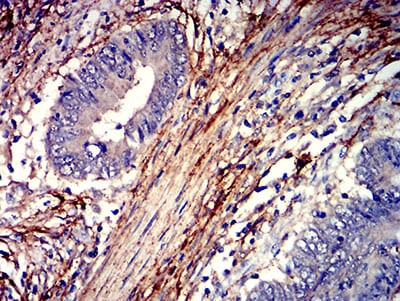

| WB | 咨询技术 | Human,Mouse,Rat |
| IF | 咨询技术 | Human,Mouse,Rat |
| IHC | 1/200 - 1/1000 | Human,Mouse,Rat |
| ICC | 技术咨询 | Human,Mouse,Rat |
| FCM | 咨询技术 | Human,Mouse,Rat |
| Elisa | 1/10000 | Human,Mouse,Rat |
| Aliases | TR; HTR; CF2R; PAR1; PAR-1 |
| Entrez GeneID | 2149 |
| clone | 5E2E6 |
| WB Predicted band size | 47.4kDa |
| Host/Isotype | Mouse IgG1 |
| Antibody Type | Primary antibody |
| Storage | Store at 4°C short term. Aliquot and store at -20°C long term. Avoid freeze/thaw cycles. |
| Species Reactivity | Human |
| Immunogen | Purified recombinant fragment of human F2R (AA: 42-176) expressed in E. Coli. |
| Formulation | Purified antibody in PBS with 0.05% sodium azide |
+ +
以下是关于 **F2R(PAR-1)抗体** 的3篇参考文献及其摘要内容:
---
1. **文献名称**: *Protease-activated receptor 1 (PAR-1) and cell signaling*
**作者**: Coughlin, S. R.
**摘要**: 该综述总结了PAR-1(F2R编码的凝血酶受体)在细胞信号传导中的作用,包括其在血小板活化、炎症和癌症转移中的功能。文章讨论了针对PAR-1的单克隆抗体在实验研究中的应用,例如通过阻断受体胞外域抑制凝血酶介导的血小板聚集,为抗血栓治疗提供潜在策略。
2. **文献名称**: *Targeting PAR1 with antibodies improves chemotherapy efficacy in melanoma*
**作者**: Arora, P., et al.
**摘要**: 本研究开发了一种靶向PAR-1的单克隆抗体(ATAP2),证明其在黑色素瘤模型中能有效抑制肿瘤细胞迁移和侵袭。实验显示,该抗体通过阻断PAR-1介导的MAPK信号通路,增强化疗药物(如达卡巴嗪)的疗效,为联合治疗提供新思路。
3. **文献名称**: *A monoclonal antibody against protease-activated receptor-1 protects mice from thrombin-induced neuroinflammation*
**作者**: Sokolova, E., et al.
**摘要**: 研究团队开发了一种抗PAR-1单克隆抗体(SPAN12),在小鼠模型中验证其抑制凝血酶诱导的神经炎症的能力。结果显示,SPAN12可减少小胶质细胞活化和促炎因子释放,提示其在脑卒中或神经退行性疾病中的治疗潜力。
---
以上文献均聚焦于PAR-1(F2R)抗体的功能机制及治疗应用,涵盖血栓、肿瘤和神经炎症等领域。如需具体期刊信息或发表年份,可进一步查阅相关数据库(如PubMed)。
**Background of F2R Antibodies**
The F2R gene encodes protease-activated receptor 1 (PAR1), a G protein-coupled receptor (GPCR) activated by proteolytic cleavage. PAR1 plays a critical role in hemostasis, thrombosis, inflammation, and cancer progression. It is primarily activated by thrombin, a serine protease, which cleaves the receptor's extracellular N-terminal domain, exposing a tethered ligand that triggers intracellular signaling. PAR1 mediates diverse cellular responses, including platelet activation, endothelial cell regulation, and tumor cell migration.
F2R-targeting antibodies are valuable tools for studying PAR1's structure-function relationships and pathological roles. In research, they help elucidate PAR1's involvement in thromboembolic diseases, inflammatory disorders, and cancer metastasis. Therapeutically, PAR1 antagonists (e.g., vorapaxar) have been developed to inhibit platelet activation, reducing thrombotic events in cardiovascular diseases. Conversely, agonistic antibodies mimicking PAR1 activation may aid wound healing or angiogenesis studies.
In oncology, PAR1 overexpression correlates with tumor invasiveness and poor prognosis. Antibodies blocking PAR1 signaling are explored for their potential to suppress metastasis or synergize with chemotherapy. Challenges include balancing efficacy with bleeding risks in antithrombotic applications and understanding PAR1's context-dependent roles in different tissues. Overall, F2R antibodies remain pivotal in dissecting PAR1 biology and advancing targeted therapies.
×